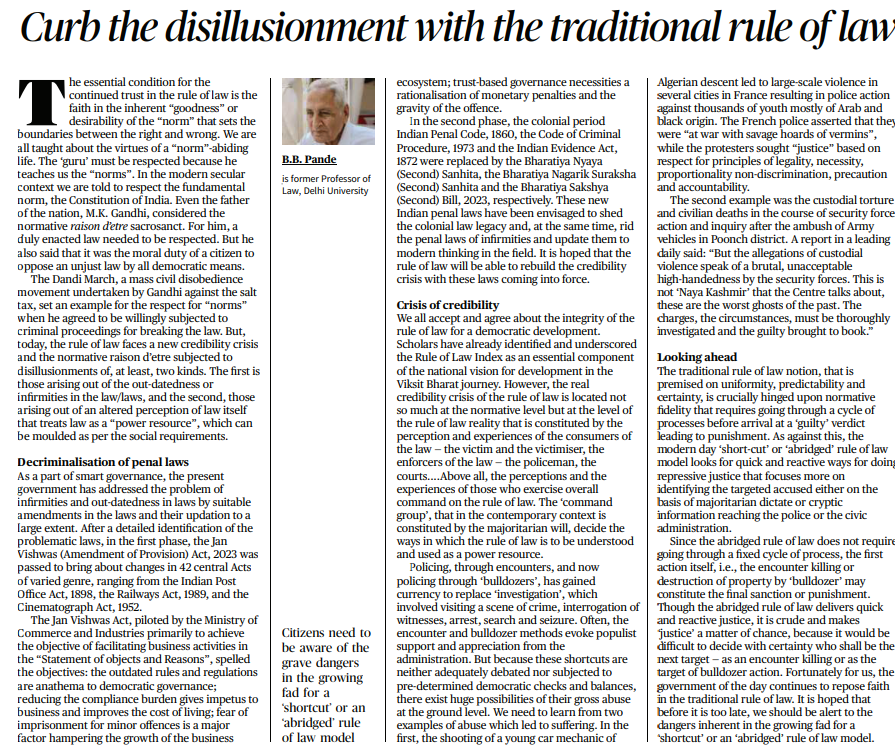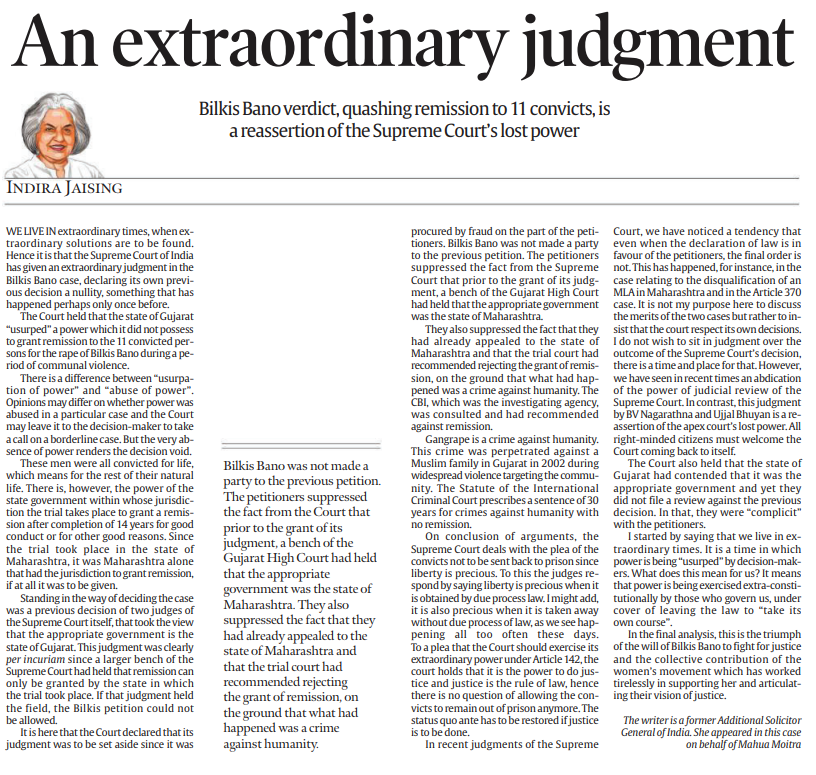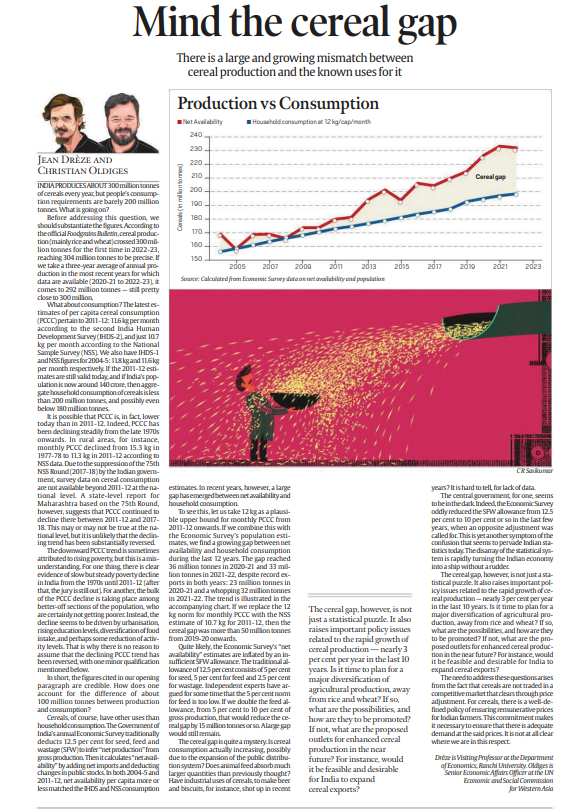The Changing Dynamics of Rule of Law
Introduction:
- The foundation of trust in the rule of law lies in the belief in the inherent goodness and desirability of the norms that delineate right from wrong.
- This faith in norms has been traditionally upheld, from respecting gurus who teach norms to venerating the Constitution.
- However, contemporary challenges pose a credibility crisis to the rule of law, stemming from outdated laws and an evolving perception of law as a malleable “power resource.”
Smart Governance Initiatives:
- To address outdated laws, the government has undertaken amendments through the Jan Vishwas (Amendment of Provision) Act, 2023, impacting 42 central Acts.
- The objectives include streamlining regulations for democratic governance, reducing compliance burdens, and fostering trust-based governance by rationalizing penalties.
Legal Reforms:
- In a second phase, the government replaced colonial-era laws like the Indian Penal Code, Code of Criminal Procedure, and Indian Evidence Act with the Bharatiya Nyaya (Second) Sanhita, Bharatiya Nagarik Suraksha (Second) Sanhita, and Bharatiya Sakshya (Second) Bill, 2023, respectively.
- These changes aim to shed colonial legacies and update laws to contemporary societal norms, hoping to rebuild the rule of law’s credibility.
Crisis of Credibility:
- The real crisis lies not only at the normative level but in the perceptions and experiences of those interacting with the law—victims, victimizers, law enforcers, and the ruling majority.
- Policing methods, such as encounters and bulldozers, have gained popularity, but their potential for abuse poses a serious threat, as exemplified by incidents in France and Kashmir.
Modern vs. Traditional Rule of Law:
- The traditional rule of law, emphasizing uniformity and due process, faces challenges from a modern “abridged” model that seeks quick, reactive justice.
- This model, relying on majoritarian dictates or cryptic information, risks making justice a matter of chance.
- While the current government continues to endorse the traditional rule of law, there is a growing concern about the rising trend of shortcuts.
Conclusion:
The evolving landscape of the rule of law necessitates a delicate balance between reforming outdated norms and preserving the essence of justice. While legal amendments are a step forward, the risks associated with an abridged rule of law model underscore the importance of vigilant governance to ensure the enduring credibility of the legal system.
Mulya Pravah 2.0" Guidelines by UGC
Introduction
- The University Grants Commission (UGC) has rapidly issued various regulations, guidelines, and directives, one of which is Mulya Pravah 2.0, a modified version of a 2019 notification.
- This guideline aims to instill human values and professional ethics in higher education institutions, responding to unethical practices highlighted by a survey of human resource managers.
Unethical Practices in Higher Education
- The trigger for Mulya Pravah 2.0 is the prevalence of unethical practices in higher education institutions, such as favoritism, gender discrimination, lack of confidentiality, and arrangements for personal gain.
- While acknowledging the UGC’s credit for addressing these issues, doubts arise about the efficacy of the guideline without sincere implementation efforts.
Emphasis on Transparency
- Mulya Pravah 2.0 emphasizes transparency in decision-making, urging institutions to act in the best interest of the public.
- It calls for the abolition of discriminatory privileges and emphasizes the importance of integrity, trusteeship, accountability, and inclusiveness.
Confidentiality Issue
- The guideline’s emphasis on confidentiality is questioned, as it seems to conflict with the right to information.
- The suggestion is made for institutions to voluntarily disclose critical information, agendas, proceedings, and annual reports to promote accountability and restore public confidence.
Expectations from Teaching Staff
- The guideline asserts teaching as a noble profession, urging educators to act as role models.
- It emphasizes adherence to institutional rules but remains silent on the matter of teachers’ associations.
Unions and Support
- Mulya Pravah 2.0 expects staff and student unions to support administration in development activities but raises concerns about potential suppression of dissent.
- The call for unions to raise issues in a “dignified manner” lacks clear definition and could be misused, posing a threat to the collective voices of stakeholders.
Challenges and Conclusion
The editorial concludes that while these guidelines aim to strengthen institutions, provisions like those concerning unions may inadvertently cause more harm than good. Discordant voices are viewed as integral to the improvement of decision quality and institutional sustainability.
Judicial Reassertion in Extraordinary Times: The Bilkis Bano Case
Introduction:
- The Supreme Court of India recently delivered an extraordinary judgment in the Bilkis Bano case, marking a rare instance of declaring its own previous decision null and void.
- This editorial analysis explores the background, legal intricacies, and implications of this landmark decision.
- Unprecedented Judgment:
- The Supreme Court took an exceptional step by nullifying its prior decision, emphasizing the state of Gujarat’s “usurpation” of power in granting remission to 11 persons convicted for the gangrape of Bilkis Bano during communal violence.
- The Court distinguished between “usurpation of power” and “abuse of power,” highlighting the void nature of a decision when power is absent.
- Jurisdictional Complexity:
- The convicted individuals were sentenced to life imprisonment, with the power to grant remission vested in the state government where the trial occurred.
- However, a previous Supreme Court decision incorrectly identified Gujarat as the appropriate government, contradicting a larger bench’s ruling that only the trial state holds this authority.
III. Fraudulent Manipulation:
- The Court revealed that its prior judgment was procured by fraud, as Bilkis Bano was not made a party, and crucial information was suppressed.
- The petitioners concealed the Gujarat High Court’s stance and their appeal to the state of Maharashtra, which opposed remission due to the gravity of the crime against humanity.
- Crimes Against Humanity:
- The gangrape against Bilkis Bano, committed during the 2002 Gujarat violence, was characterized as a crime against humanity.
- The International Criminal Court’s statute prescribes a 30-year sentence with no remission for such offenses.
- Upholding Due Process:
- Addressing the convicts’ plea for liberty, the Court asserted that liberty is precious when obtained through due process of law.
- It rejected calls for extraordinary powers, emphasizing the restoration of the status quo ante to uphold justice.
- Judicial Accountability and Review:
- The judgment critiqued recent instances of the Supreme Court’s divergence between the declaration of law and the final order.
- It stressed the importance of the court respecting its own decisions, signaling a reassertion of judicial power.
VII. Complicity of Gujarat:
The Court highlighted the complicity of the state of Gujarat, which failed to challenge the prior decision, further underscoring the irregularities surrounding the case.
VIII. Triumph of Justice:
- The judgment ultimately acknowledges the triumph of Bilkis Bano’s relentless pursuit of justice and credits the collective efforts of the women’s movement supporting her cause.
- It reflects a reaffirmation of the judiciary’s role in upholding justice in times marked by the extrajudicial exercise of power.
Conclusion:
In an era of extraordinary challenges, the Bilkis Bano case stands as a testament to the judiciary’s resilience and commitment to justice. The decision not only corrects legal anomalies but also underscores the imperative for due process and accountability in the face of power usurpation.
India's Cereal Gap: Unraveling Production and Consumption Discrepancies
Introduction:
– India produces 300 million tonnes of cereals annually, exceeding consumption needs of 200 million tonnes.
– Figures from the Foodgrains Bulletin indicate cereal production crossed 300 million tonnes in 2022-23.
– The surplus production raises questions about utilization, distribution, and potential policy implications.
– Understanding the dynamics between production and consumption is crucial for agricultural planning and food security.
Consumption Trends:
– Per capita cereal consumption (PCCC) estimates from 2011-12 show a decline, with varying figures from IHDS-2 and NSS.
– PCCC has been steadily decreasing since the late 1970s, driven by urbanization, education levels, diversified food intake, and potential reduction in activity levels.
– The rural areas have experienced a significant decline in monthly PCCC from 15.3 kg in 1977-78 to 11.3 kg in 2011-12 according to NSS data.
– The suppression of the 75th NSS Round in 2017-18 limits data availability, but state-level reports suggest continued decline in some regions.
Production-Consumption Discrepancy:
– The gap of about 100 million tonnes between production and consumption raises questions about the efficiency of the supply chain.
– Factors like storage losses, transportation issues, and inefficient distribution systems may contribute to the discrepancy.
– Understanding the specific uses of cereals beyond household consumption, such as industrial processing and animal feed, is essential.
– Examining regional variations in production and consumption patterns could provide insights into the overall discrepancy.
Economic Survey’s Perspective:
– The Economic Survey deducts 12.5% for seed, feed, and wastage (SFW) to calculate “net availability.”
– Recent years witness a significant gap between net availability and household consumption, reaching 36 million tonnes in 2020-21 and 33 million tonnes in 2021-22.
– Assessing the accuracy of the SFW deduction is crucial for understanding the actual availability for consumption.
– The reduction in the SFW allowance from 12.5% to 10% by the Economic Survey raises concerns about the reliability of the figures.
Potential Explanations for the Discrepancy:
– Doubts raised about the sufficiency of the SFW allowance, especially the low 5% norm for feed.
– Adjusting the feed allowance to 10% could reduce the cereal gap, but a considerable gap would persist.
– The discrepancy may be attributed to inadequate data on emerging trends like increased cereal consumption, greater animal feed usage, or industrial applications.
– Collaborative efforts between the government and independent experts are essential to refine data collection methodologies and improve accuracy.
Unanswered Questions and Policy Implications:
– The cereal gap presents a mystery, with potential factors like increased cereal consumption, greater animal feed usage, or industrial applications.
– Lack of data hampers understanding, and the central government’s reduction of SFW allowance adds to the confusion.
– Raises critical policy issues regarding the growth of cereal production and the need for diversification.
– Policymakers must address the challenges posed by the cereal gap, considering the implications for farmers, consumers, and the overall economy.
Policy Considerations:
– With nearly 3% annual growth in cereal production, is it time for a shift away from rice and wheat?
– Exploration of possibilities and promotion strategies for diversification are crucial.
– Consideration of the feasibility and desirability of expanding cereal exports in response to increased production.
– Policymakers should engage in a comprehensive review of existing agricultural policies to align them with evolving production and consumption patterns.
Conclusion:
– The cereal gap not only poses a statistical puzzle but also demands attention to policy issues and planning for the future of agricultural production in India.
– The commitment to ensuring remunerative prices for farmers necessitates clarity on demand dynamics in the context of evolving consumption patterns.





